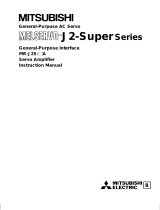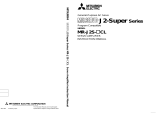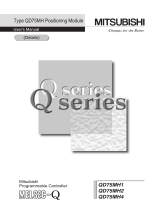Page is loading ...

Cautions on Safety
Make sure to read the manuals and pay careful attention to safety when designing a system.
In practice, pay attention to the following contents and handle any products or demonstration
units correctly.
Cautions on practice
DANGER
• Never touch any terminal while the power is supplied. If you touch a terminal,
you may get an electrical shock.
• Turn off the power before connecting / disconnecting units, or opening any
safety covers.
• Never insert your hand or any other object into a moving part.
CAUTION
• Never change the wiring or configuration of demonstration euipment without
permission or if you are unsure of how to configure a system correctly. Such
actions may cause failure, malfunction, injury or fire.
• If a simulation unit (such as an X-Y table) generates an abnormal smell or
sound, immediately turn off the power switch.
• If you detect any abnormality, immediately turn off the power and contact a
qualified engineer.
Positioning Control

i
Positioning Control
Manual number: JY992D89901
Manual revision: A
Date : July 2000
Positioning Control

Positioning Control
ii

FAX BACK
Mitsubishi has a world wide reputation for its efforts in continually developing and pushing back
the frontiers of industrial automation. What is sometimes overlooked by the user is the care
and attention to detail that is taken with the documentation. However,to continue this process
of improvement, the comments of the Mitsubishi users are always welcomed. This page has
been designed for you,the reader,to fill in your comments and fax them back to us. We look for-
ward to hearing from you.
Fax numbers: Your name....................................................
Mitsubishi Electric.... .....................................................................
America (01) 847-478-2253 Your company..............................................
Australia (02) 638-7072 .....................................................................
Germany (0 21 02) 4 86-1 12 Your location: ...............................................
South Africa (0 27) 11 444-0223 .....................................................................
United Kingdom (01707) 278-695
Please tick the box of your choice
What condition did the manual arrive in?
Good Minor damage Unusable
Will you be using a folder to store the manual?
Yes No
What do you think to the manual presentation?
Tidy Un-friendly
Are the explanations understandable?
Yes Not too bad Unusable
Which explanation was most difficult to understand:..................................................................
....................................................................................................................................................
Are there any diagrams which are not clear?
Yes No
If so,which:..................................................................................................................................
What do you think to the manual layout?
Good Not too bad Un-helpful
If there one thing you would like to see improved,what is it?......................................................
....................................................................................................................................................
....................................................................................................................................................
Could you find the information you required easily using the index and/or the contents,if possi-
ble please identify your experience: ...........................................................................................
....................................................................................................................................................
....................................................................................................................................................
....................................................................................................................................................
....................................................................................................................................................
Do you have any comments in general about the Mitsubishi manuals?.....................................
....................................................................................................................................................
....................................................................................................................................................
....................................................................................................................................................
....................................................................................................................................................
Thank you for taking the time to fill out this questionnaire. We hope you found both the
product
and this manual easy to use.
Positioning Control
iii

Positioning Control
iv

Positioning Control
v
Introduction
This manual describes basic operation for those who learn positioning control for the first time,
the aim being so that they can get training using demonstration units of Mitsubishi FA
equipment.
The following relevant manuals are available and should be referred to
Manual Name Number
FX-10GM/FX(E)-20GM Hardware and Programming manual JY992D60401
FX-10GM Users Guide JY992D68401
FX
2N
-10GM/FX
2N
-20GM Hardware and Programming manual JY992D77801
FX2N-10GM Users Guide JY992D77701
FX2N-20GM Users Guide JY992D77601
FX-PCS-VPS Win-E Software Manual JY992D86801
FX
2N
-10GM/FX
2N
-20GM Connection Manual JY992D81601

Positioning Control
vi

Positioning Control Contents
vii
1. The World of Positioning Control...........................................................1-1
1.1 Welcome to the new world! .................................................................................1-1
1.2 Diversified actuators............................................................................................1-2
1.3 Positioning method type......................................................................................1-4
2. Positioning by AC Servo System...........................................................2-1
2.1 When an AC servo system is introduced.............................................................2-1
2.2 Examples of AC servo systems...........................................................................2-3
3. Components of Positioning Control and Their Roles ............................3-1
3.1 Positioning controller ...........................................................................................3-4
3.1.1 Command pulse and feed quantity............................................................................3-4
3.1.2 Command pulse and feed speed ..............................................................................3-4
3.1.3 Setting the acceleration/deceleration time ................................................................3-5
3.1.4 Backlash correction function .....................................................................................3-5
3.1.5 Zero point return function ..........................................................................................3-6
3.2 Servo amplifier and servo motor..........................................................................3-7
3.2.1 Positioning control in accordance with command pulse............................................3-7
3.2.2 Deviation counter function.........................................................................................3-7
3.2.3 Servo lock function....................................................................................................3-7
3.2.4 Regenerative brake function .....................................................................................3-8
3.2.5 Dynamic brake function.............................................................................................3-8
3.3 Drive mechanism.................................................................................................3-9
3.3.1 Concept of drive system movement quantity ............................................................3-9
3.3.2 Setting the target position........................................................................................3-11
4. Advanced Positioning............................................................................4-1
4.1 Interpolation control.............................................................................................4-1
4.2 Other controls......................................................................................................4-3
5. Actual Positioning..................................................................................5-1
5.1 Demonstration Equipment...................................................................................5-1
5.1.1 Basic Set ...................................................................................................................5-1
5.1.2 Comprehensive Set...................................................................................................5-1
5.2 Operation of the demonstration equipment .........................................................5-2
5.2.1 Program example......................................................................................................5-3
5.2.2 Writing the program...................................................................................................5-4
5.2.3 Parameters................................................................................................................5-5
5.2.4 Operation...................................................................................................................5-7
6. Product Line up.....................................................................................6-1
6.1 Position controller................................................................................................6-1
6.2 Servo amplifier.....................................................................................................6-5
6.3 Servo motor.........................................................................................................6-7
Appendix A:..............................................................................................A-1
A-1: Tentative Selection of Motor Capacity.................................................................A-1
A-1-1: Motor effective torque................................................................................................A-2
A-1-2: Load inertia moment..................................................................................................A-4

Positioning Control Contents
viii


The World of Positioning Control 1
1-1
1. The World of Positioning Control
1.1 Welcome to the new world!
The positioning controller, together with the programmable controller, personal computer and
operator interface, is one of the four main units of FA (factory automation).
Among them, the positioning controller is important as the basis of FA, and regarded as the
center of the mechatronics field in which many senior engineers have been playing active
parts.
Positioning is all about motion, and motion often involves speed and precision. As speed can
be related to productivity, it is an area of much development. But, when the machine speed
increases, a problem with the stop precision is often generated. In order to solve this problem,
diversified grades of position controllers have been required and developed.
Improvement of the machine efficiency generates immeasurable added value, including
reduction of labour and the machine floor area for the same quantity of production.
If there are no problems related to the positioning aspect of a machine, it may mean that the
machine is not running most efficiently. Here is where the science of developing an optimum
positioning control system comes in.
Positioning Control

Positioning Control The World of Positioning Control 1
1-2
1.2 Diversified actuators
• A power source which moves an element in a system is called actuator. A unit which detects
a position of a work piece or moving part is called sensor.
• Diversified actuators and sensors, from simple ones to enhanced ones, are used in
positioning.
• This paragraph describes representative types, their features and weak points.
Pneumatic
• Air source and high grade piping are
required.
• High torque is not available.
• Multi-point positioning is complex and
very difficult to achieve.
• Change in positioning is difficult.
Brake motor
• Positioning mechanism is simple.
• Repeatability is poor.
• Change in positioning is difficult.
(When optical sensors or limit switches are
used for stop)
Clutch brake
• Frequent positioning is available.
• Life of friction plate is limited.
• Change in positioning is difficult.
(When optical sensors or limit switches are
used for stop)

Positioning Control The World of Positioning Control 1
1-3
Stepping motor
• Positioning mechanism is simple.
• If load is heavy, motor may step out and
displacement can occur.
• Motor capacity is small.
• Precision is poor at high speed.
DC servo system
• Positioning precision is good.
• Maintenance is required for motor
brushes.
• It is not suitable for rotation at high
speed.
General purpose inverter and general
purpose motor
• Multi-speed positioning is available
using high-speed counter.
• High precision positioning is not
available.
• Large torque is not available at start.
(Specialized inverter is required)
AC servo system
• Precision is good.
• Maintenance is not required.
• Positioning address can be easily
changed.
• It is compact, and offers high power.

Positioning Control The World of Positioning Control 1
1-4
1.3 Positioning method type
1) There are three types of positioning method
*1 The stop precision shows a value in a case where low speed is 10 to 100 mm/s.
Control method Description Schematic drawing
Speed
control
Limit
switch
method
Two limit switches are
provided in places where a
systems moving part
passes. At the first limit
switch, the motor speed is
reduced. At the second limit
switch, the motor turns off
and the brake turns on, to
stop the moving part.
In this method, because
position controllers are not
required, the system
configuration can be realized
at reasonable cost.
(Guideline of stopping
precision: Approximately
±1.0 to 5.0 mm)*
Pulse
count
method
A position detector (such as
pulse encoder) is set up in a
motor or rotation axis. The
pulse number generated
from the position detector is
counted by a high-speed
counter. When the pulse
number reaches the preset
value, the moving part stops.
In this method, because limit
switches are not used, the
stop position can be easily
changed.
Position
control
Pulse
command
method
An AC servo motor which
rotates in proportion to the
input pulse number is used
as the drive motor.
When the pulse number
corresponding to the
movement distance is input
to the servo amplifier of the
AC servo motor, positioning
can be performed at high
speed in proportion to the
pulse frequency.
B IM
INV
DC0 to 10V
High speed
Low speed
Limit switch for
changeover to
low speed
Limit switch
for stop
Ball screw
IM: Inductive motor
B: Brake
INV: Inverter
Moving part
Movement
distance
PLG
High speed
Low speed
Ball screw
IM: Inductive motor
PLG: Pulse generator
INV: Inverter
PLC: Programmable controller
Moving part
Movement distance
PC
High-speed
counter unit
DC0 to
10V
Pulses are
fed back.
IM
INV
PLG SM
Servo
amplifier
Ball screw
SM: Servo motor
PLG: Pulse generator
PLC: Programmable
controller
Moving part
Movement distance
PC
Position controller
Pulses are
fed back.
Command
pulse

Positioning Control The World of Positioning Control 1
1-5
2) Positioning method and stop precision
< Limit switch method >
- When automatically stopping a moving
part driven by a motor, stop the motor by a
position signal, detected by a limit switch
(in general conditions, turn on the brake at
the same time).
- The moving part continues by a coasting
distance until it completely stops, after the
stop command is given. The coasting
distance is shaded in the figure.
- The stop precision is equivalent to the
dispersion in the shaded area as shown in
the figure on the left.
The dispersion is affected by the speed
when the stop command is given, the load
size and the time delay since the stop
command is given, until speed reduction
actually starts.
- If the required stop precision is not
satisfactory when stopping from the
normal operation speed, the most effective
method to improve the stop precision is to
reduce the operation speed.
- However, if the operation speed is simply
reduced, the machine efficiency may also
be reduced. In actual operation, the motor
speed can be reduced from high speed to
low speed once, then the motor stopped.
Velocity
Stop command
Stop
Time
Coasting
distance
Velocity
Stop command
Stop
Time
Light load
Large inertia
Stop
Dispersion
in stop
Heavy
load
Small
inertia
Speed reduction start
Time delay
Velocity
Speed reduction command
Time
Stop command
Dispersion
in stop
High speed
Dispersion in
speed reduction
distance

Positioning Control The World of Positioning Control 1
1-6
< Pulse count method >
- When a pulse encoder is attached to a moving part, and the motor speed is controlled by
a number steps while the pulse number is counted, the movement quantity per pulse is
determined in accordance with the relationship between the pulse number generated by
one rotation of the encoder, and the movement quantity of the moving part (workpiece)
realized by one rotation of the motor. The movement quantity per pulse is regarded as
the minimum unit for the stop command.
- However, the coasting distance at stop is not eliminated.
< Pulse command method >
- In this method using a servo system, the weak points described above are improved. A
pulse encoder is attached to the servo motor, detecting the motor rotation quantity
(workpiece movement distance), to continuously and directly control the speed from the
high-speed operation to the target position, which allows the workpiece to stop with good
precision.
- As the coasting distance at stop is eliminated, the positioning precision is improved.

/






